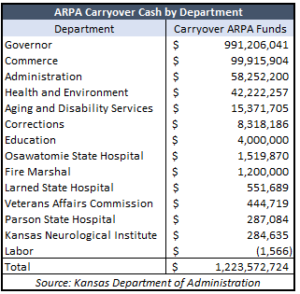While Kansas families and businesses are still struggling to recover from government-imposed shutdowns, COVID-19 restrictions, and inflation, the Kelly administration is sitting on $1.2 billion of unspent ARPA money. Federal APRA money has specific limits on its usage, but in general, it’s used to make up for financial losses during the COVID-19 pandemic or one-time projects. But much of the state’s dole was still sitting in the bank at the end of June.
This information, along with the unencumbered cash balances in each of the more than 2,000 funds operated by state agencies, was received through Kansas Open Records Requests and can be found on KansasOpenGov.org.
 The report included breakdowns of what types of funds were left over, including those from ARPA. In total, the state finished FY 2022 with $6.6 billion (net) in unencumbered cash, including $1.2 billion of ARPA across multiple funds. For instance, the Governor’s Office has a whopping $991.2 million in its ARPA fund, which is more than the extra $875.5 million the state ended with last year. Commerce has $99.9 million and Administration has $58.25 million in their ARPA funds as well.
The report included breakdowns of what types of funds were left over, including those from ARPA. In total, the state finished FY 2022 with $6.6 billion (net) in unencumbered cash, including $1.2 billion of ARPA across multiple funds. For instance, the Governor’s Office has a whopping $991.2 million in its ARPA fund, which is more than the extra $875.5 million the state ended with last year. Commerce has $99.9 million and Administration has $58.25 million in their ARPA funds as well.
ARPA, standing for the American Rescue Plan Act, was a $1.9 trillion COVID-19 relief package passed in 2021. Governments across Kansas were allocated $4.9 billion. $1.6 billion went directly to the state government, with the other $3.3 billion going to counties, cities, school districts, and other projects and entities across the state. The funds have come in waves between 2021 and 2022 and must be spent by the end of 2024.
The big reserves come amidst increasing concerns about the transparency of state ARPA funds. Kansas was one of seven to states not to distribute ARPA as part of a budget process, instead creating a method by which proposals are made and reviewed by various panels.
ARPA was passed because of fears of an “unprecedented revenue collapse” at the onset of the COVID-19 pandemic. But two years later, Kansas has had its 25th month in a row of exceeding revenue estimates, leading to the high General Fund surplus even after a multi-million dollar deposit into the state’s budget stabilization fund. The result of the federal wave of cash has been high inflation across the country.
Being awash in cash is good for big government spenders, but not for ordinary Kansas families who aren’t seeing tax relief amidst a rough economy. Kansas is still 19,500 jobs below its pre-pandemic levels, lagging behind the 23 states that have already exceeded their pre-pandemic job numbers. Inflation is eating further into Kansas’ lagging wage growth – 13th lowest nationwide – hurting families and businesses more than they already were struggling through the pandemic.
Instead of dolling more billions in economic development follies that give big money to megaprojects and big corporations, the data shows that economic growth comes from tax relief for ordinary people in the economy. Tax cuts for people with lower incomes have resulted in high employment growth.





